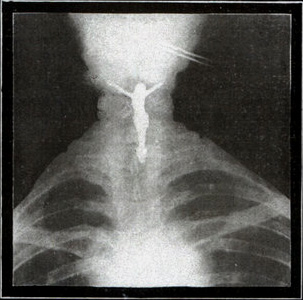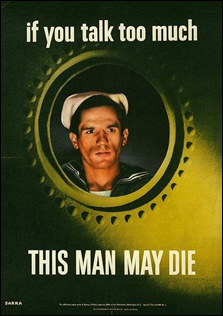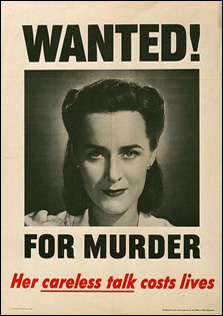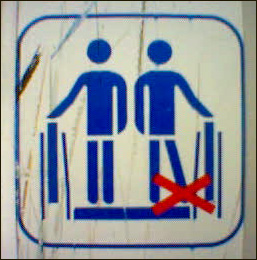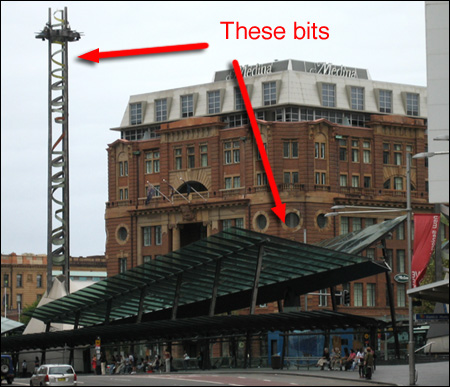
The next stop on our Bad Public Art Tour of Sydney takes in a combination of art and architecture, the sum of which truly amounts to a greater travesty than its parts. Feel free to aim your cameras at the 1999 makeover of Sydney’s major bus and rail interchange Railway Square.
The overall cost for this unmitigated disaster is variously quoted as $12 million or $20 million dollars. Either way it is money that could have been spent a lot better.
The government architects that won the tender for the job (let me guess – they were the cheapest…) have managed to effortlessly combine complete lack of utility with ugliness. This is no mean feat. (It’s not unusual to see one or the other – pretty but useless, or useful but hideous – but to manage both simultaneously takes a particular level of ineptness).
If you scrutinize the image above, you will immediately see one of the first problems you might encounter as a commuter seeking shelter under the bus shelter. Yes, that’s right. There is none. Even the mildest amount of rain manages to swish its way under the stupidly swept-up roofs of the thing, and if there’s any serious rain and/or wind, the elements are focussed in such a manner that you’d probably be better off standing on an unsheltered street. I speak from experience.
At the opening of the building, the government architect Chris Johnson ((Elsewhere the architecture is credited as “conceived by DPWS architect Margaret Petrykowski”. No-one is very happy to take responsibility for this mess.)) was questioned by a reporter about the lack of effectiveness of the shelter in inclement weather. He replied, bafflingly:
“During a strong southerly wind, there may be a problem with rain. But people have to walk through the rain from the home.”
Er… yes, Mr Johnson, so what you’re saying is, er, that since they’re already wet, then it doesn’t matter that the shelter is crap?
In the Hansard extract where that snippet of peculiar reasoning appears, The Hon. E. M. Obeid on behalf of the Minister for Public Works and Services declares:
“The weight of opinion is that this has been an excellent result, which has dramatically improved both the flow of buses and the amenity and facilities for commuters.”
Which begs the question: The weight of whose opinion, exactly? I’m thinking it’s not going to be the soggy people waiting in the wind-tunnel for their 20-minute-late bus.
Now if you’ll just follow me this way, I’ll ask you to turn your attention to the next feature of this work – the lighting towers. I use the word ‘lighting’ parenthetically. I don’t think I’ve ever actually seen the lights working. I know they must have at some time or other, because there are pictures of them illuminated. Most times I go past at night, however, they are just big dark gloomy junk-metal towers. The thought invariably comes into my mind that they will look exactly appropriate when the apocalypse comes.
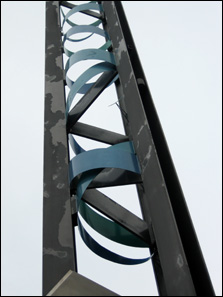
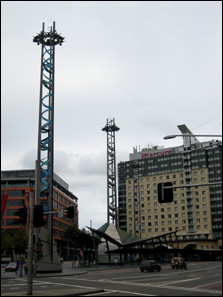
Aside from their lack of luminance, the other great feature of these radio-tower maquettes is the great shreds of coiled metal that spiral down their insides. It reminds me of nothing so much as a gargantuan replica of the mess you get if you tear up an aluminium soft-drink can.
The overall effect of the Railway Square edifice is one of complete industrial chaos. It’s as if someone rifled through a gigantic mechanical scrap heap and then dumped the lot in a pile. There is no thought of harmony at all, either within the creation itself, or with the surrounding environment.
To make matters worse, the structures are looking very shabby indeed now. The paint on the towers is peeling off, and the glass on the shelters is dirty and covered in bird shit. I don’t believe it has ever been cleaned. It’s not the way you’d expect to see something treated if you were proud of it.
Back in 1999, The Minister finished off his defense of the interchange revamp in parliament by opining through Mr Obeid:
“It is a clean and modern facility and one that, as time passes, will become accepted as not only an important transport interchange, but as a new gateway to the city.”
Well, Minister, time has indeed passed and I think that most of my fellow citizens and commuters would agree with me that after 8 years of practical interaction with this incarnation of Railway Square, it is not looked upon by us with even the remotest degree of fondness, and certainly not accepted as any ‘gateway to the city’. It is, at best, just barely tolerated.
